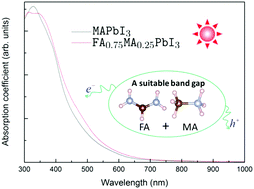The mixing effect of organic cations on the structural, electronic and optical properties of FAxMA1−xPbI3 perovskites
Abstract
Organic–inorganic hybrid perovskites as new emerging functional materials stand out from numerous photovoltaic materials thanks to the unprecedentedly rapid improvement of their power conversion efficiency within a short period. To explore potentially more efficient photovoltaic candidates, the structural and electronic properties of FAxMA1−xPbI3 based on prototype MAPbI3 are investigated for superior performance. Specifically, structural relaxation is performed at the PBE+D2 level and the electronic and optical properties are investigated at the HSE + SOC level. Optical simulations show that significantly improved performance can be successfully achieved by means of the injection of FA cations. Moreover, the calculations of defect formation energies imply that MA-poor ambient conditions are energetically favorable to synthesize a variety of FA-doped pervoskite compounds FAxMA1−xPbI3 of different ratios. It is interesting to find that compared with the prototype MAPbI3, the optical performance of the perovskite series FAxMA1−xPbI3 is effectively improved with an increase in FA content; meanwhile the relative stability of the perovskite series is also efficiently enhanced. Our study not only sheds new light on further understanding perovskite absorbers but also provides the basic rationale for designing new functional materials used for photovoltaics.



 Please wait while we load your content...
Please wait while we load your content...